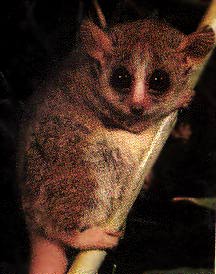Primates have certain senses
that are more important than others. The shape of the face and skull in
primates reflects the senses that are most important. It is important to
realize that the shape of an animal is related to the activities of the
animal.
All primates rely more on sight than any other sense. As a result, primate skulls are shaped in a way to maximize their vision. The eyes of primates are located in the front of the face, rather than on the side of the head as they are in dogs or horses. Due to the forward position of the eyes, primates are capable of stereoscopic vision, and thus they have depth perception.
 Stereoscopic
Vision
Stereoscopic
Vision
Why would stereoscopic vision be important to a primate? Would it be important to a cow? Can you think of any other animals who have stereoscopic vision? Why would it help these animals?
The eyes of primates are oriented to the front and protected by a relatively thick bone. The bone surrounding the lateral side and back of the eye is called a post-orbital wall. The amount of boney wall surrounding the eye varies between primates. In some primates, there is only a bar of bone on the lateral side of the eye. This is called a post-orbital bar. In other primates, the whole side and back of the eye is protected by bone, thus they have a post-orbital wall.
What senses do you think cats
rely most on?
Why?